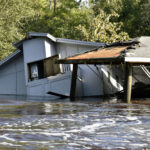As a Florida homeowner, there is no better time than now to take precautions and ensure your landscaping is hurricane-ready this season. Hurricanes can bring with them drenching rains, powerful winds and flooding—all of which can wreak havoc on your curb appeal.
While there’s no way to completely avoid the damage that Mother Nature can bring during these wild storms, preparing now will go far in minimizing it. From assessing threats posed by coastal tides to creating windbreaks around buildings, follow these essential tips for protecting your landscape from hurricanes this season!
Potential Impacts of Hurricanes on Landscaping
With the devastating power that hurricanes bring, it’s no surprise that they can wreak havoc on our landscapes. Not only do these natural disasters wreak destruction on homes and buildings, but they can also uproot trees, decimate gardens, and obliterate entire landscapes. The impact of hurricanes on landscaping can result in a loss of vegetation, soil erosion, and a change in the overall aesthetic of an area.
In the aftermath of such events, it’s crucial to address the damages and take measures to restore and protect our outdoor environments. By understanding the potential impacts of hurricanes on our landscapes, we can better prepare and mitigate the damage caused by these catastrophic events.
Inspecting Your Landscape for Vulnerabilities
Identifying Vulnerable Areas of Your Landscape
There’s no question that having a beautiful landscape is one of the biggest joys of a homeowner. However, it’s important to remember that your landscape may also be susceptible to vulnerabilities that could cause damage to your property. Identifying these vulnerable areas beforehand can help you take preventative measures and avoid costly repairs down the line. Some common vulnerable areas to inspect include the slope and drainage of your land, the quality of your soil, and the placement of trees and other plants. By taking a proactive approach and inspecting your landscape for vulnerabilities, you can ensure that your outdoor space remains not only beautiful but also safe and secure for years to come.
Inspecting Trees for Damage and Disease
As a homeowner or property manager, it’s crucial to keep an eye out for any vulnerabilities in your landscape, and that includes inspecting trees for damage and disease. Healthy trees not only add aesthetic value to your property, but they also provide a myriad of environmental benefits, such as cleaning the air and reducing energy costs. By conducting regular inspections, you can identify potential issues early on and take the necessary steps to address them before they escalate into more significant problems. Look for signs of decay, insect infestations, cracks in the trunk, or dead branches that could fall and cause damage or injury. Remember, prevention is always better than cure, so don’t neglect your trees’ health!
Evaluating Your Drainage
Evaluating your landscape’s drainage may not be at the forefront of your mind when it comes to designing your outdoor space, but it’s an important aspect to consider for overall functionality and durability. Proper drainage can prevent standing water, erosion, and other damages that could harm your property. Take a stroll around your landscape and inspect for any potential vulnerabilities that could compromise your drainage system. Pay attention to low-lying areas or places where water tends to pool. Determining these problem areas early on can help you take preventative measures such as installing proper drainage mechanisms or adjusting the slope of your yard. By taking the time to evaluate your landscape’s drainage, you’ll ensure a healthier and more sustainable environment for your outdoor enjoyment.
Checking Your Hardscape
As much as we love our outdoor living spaces, it’s important to remember that our hardscapes – concrete patios, stone walkways, brick walls, and the like – are not invincible. They can deteriorate over time due to age, weather exposure, or subpar craftsmanship. It’s critical to inspect these areas regularly to ensure they’re structurally sound and safe for everyday use. One way to check for vulnerabilities is to look for any cracking, shifting, or settling that may have occurred. Additionally, keep an eye out for loose or missing pavers or bricks, as these can be tripping hazards. By taking these preventative measures, you can not only extend the life of your hardscape, but also ensure that you and your loved ones can safely enjoy your beautiful outdoor space for years to come.
Prepare Landscaping for High Winds:
Trimming Your Trees and Shrubs
Preparing your landscape for high winds is essential to protect your home and property from potential damage. One important step to take is trimming your trees and shrubs. This helps to eliminate any weak or dead branches that can easily snap during a storm and cause harm. However, it’s important to make sure you’re pruning your plants correctly to avoid injuring them or leaving them vulnerable. Consult with a professional landscaper or arborist if you’re unsure of the proper way to trim your trees and shrubs. With the right preparation and care, you can help ensure that your landscape withstands any high winds that may come your way.
Reinforcing Your Trees
Preparing your landscape for high winds is an essential step in ensuring your property stays protected during inclement weather. Reinforcing your trees is one of the most critical aspects of this preparation process. High winds can easily uproot trees, causing severe damage to your property and surrounding areas. By reinforcing your trees with sturdy stakes, you can increase their stability and resilience during strong winds. Additionally, ensure that your trees are regularly pruned to minimize the potential for weak branches to break off and cause damage. Proper preparation can help you avoid the stress and cost of unpredictable storm damage.
Performing Regular Maintenance
As homeowners, it’s essential to be proactive in preparing your landscape for high winds. Performing regular maintenance is a crucial step in preventing potential damage to your property. Start by inspecting your trees and shrubs, removing any dead or weak branches that could break off during a storm. Check your gutters and downspouts, ensuring they are free of debris that could block proper water flow. Keeping your lawn mowed and well-trimmed is also vital, as long grass and overgrown vegetation can become a potential fire hazard during high winds. By taking the time to perform these routine tasks, you can help protect your home and family from the unpredictable nature of Mother Nature.
Staking Plants and Shrubs
When it comes to preparing your landscape for high winds, staking your plants and shrubs is a crucial step in protecting them from potential damage. This process involves securing the plants to stakes, wooden poles driven into the ground for support, using soft, flexible materials that won’t cause abrasions to the plant or shrub. Staking gives plants and shrubs extra support during heavy winds, preventing them from getting uprooted or bending and breaking under pressure. It’s especially important for newly planted trees and shrubs with shallow root systems. Don’t wait until a storm is approaching to stake your plants and shrubs – take action now to protect your landscape from high winds.
Bringing Potted Plants Close to the House
When high winds are in the forecast, it’s important to take precautions to protect your yard and outdoor furnishings. One of the simplest steps you can take is to bring potted plants closer to your house. By placing them near a wall or under a covered porch, you can shield them from the full force of the wind. This not only protects your investment in your plants but can also prevent them from becoming projectiles that could damage your home or other structures on your property. So, next time you hear about an impending storm, be sure to take a few minutes to move your potted plants to a safer location.
Prepare Landscaping for Flooding:
Creating Swales and Ridges
Preparing your landscape for potential flooding is an important step in protecting your property and keeping your family safe. One effective way to do this is by creating swales and ridges in your yard. Swales are shallow channels that help to direct water away from your home, while ridges are raised areas that can redirect water flow. These natural solutions can help to prevent erosion, control water runoff, and limit potential damage from flooding. By implementing these features into your landscape, you can make sure that your property is well-equipped to handle whatever Mother Nature may throw your way.
Installing Drainage Systems
When it comes to preparing your landscape for flooding, one important step is installing drainage systems. Proper drainage can help prevent water from pooling in your yard and damaging your property. Depending on the size and layout of your property, there are a variety of drainage systems to choose from, including french drains, dry wells, and catch basins. It’s important to assess your property’s specific needs and consult with a professional to determine the best drainage system for you. Installing a drainage system can be a small investment that can save you from expensive water damage in the long run.
Elevating Plants and Soil
Preparing your landscape for potential flooding is crucial in ensuring the survival of your plants and soil. One effective method is elevating them to higher ground or mounds, creating a barrier that will prevent the water from reaching them. This is crucial as flooding can cause severe damage to your landscape, washing away topsoil and drowning plants. It is important to note that when elevating your plants, ensure that you are not burying their roots too deep as this can cause root rot, leading to further damage. Additionally, it is essential to use high-quality mulch to cover the area extensively, as this will hold the soil in place and prevent erosion. Overall, an elevated landscape can mean the difference between a healthy garden and extensive damage.
Choosing Flood-Resistant Plants
When it comes to preparing your landscape for potential flooding, selecting flood-resistant plants should be at the top of your to-do list. These types of plants have the ability to tolerate extended periods of inundation and can aid in reducing soil erosion. Take, for example, the cardinal flower or the rose mallow; both can handle wet soil conditions without suffocating their roots. Other flood-resistant options include the black gum and the switchgrass. It’s important to note that just because a plant is labeled “drought-resistant” does not necessarily mean it can weather the storm during a flood. By selecting flood-resistant plants, you can rest easy knowing your landscape will not only look beautiful but can also withstand potentially destructive weather conditions.
Preparing your landscape for hurricane season is no easy task. You need to identify vulnerable areas, inspect trees and drainage, check the hardscape, trim plants, reinforce trees, perform maintenance, stake plants, bring potted plants close to the house, create swales and ridges, install drainage systems, elevate plants and soil and choose flood-resistant plants.
All of these are important steps in making sure that your landscaping is prepared for whatever winds and rains hurricanes bring. While this blog post delves into many aspects of hurricane preparation for your landscaping needs, there is still much more you should consider.
Be sure to check out our other posts in our hurricane season prep series for further information on how best to prepare your outdoor space during hurricane season.








